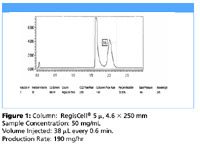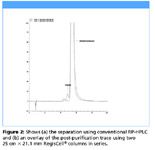Separation and Scale-Up of an Achiral Compound Utilizing the RegisCell® CSP
Although supercritical fluid chromatography (SFC) is generally regarded as a technique to separate enantiomers, it has also been proven in many laboratories as a fast approach for the purification of impurities in achiral samples.
Eric E. Pullen, Andrew G. Geyer, and Vinay M. Edwin, Regis Technologies, Inc.
Although supercritical fluid chromatography (SFC) is generally regarded as a technique to separate enantiomers, it has also been proven in many laboratories as a fast approach for the purification of impurities in achiral samples.

Figure 1
A proprietary active pharmaceutical ingredient (API) was examined by both RP-HPLC and SFC methodology for the elimination of a ~0.8% impurity. The compound of interest and the impurity have a M.W. > 350 daltons and differ structurally by only an acetamide versus a formamide group.
The best RP-HPLC method found for the separation was isocratic with a high percentage of an R-OH solvent with H20 on a C18 column.

Figure 2
A method utilizing 35% MeOH in CO2 on a RegisCell® column was developed for SFC. Figure 1 illustrates the analytical separation and subsequent loading calculations.
Experimentally Determined Production Rates
Single Column:
25 cm X 4.6 mm – 190 mg/h
25 cm X 21.1 mm – 4.6 gm/h
Serially Coupled Columns:
Two - 25 cm X 4.6 mm – Not performed
Two - 25 cm X 21.1 mm – 16 gm/h
Conclusions
As shown, the ability to separate the desired compound from the main impurity would be extremely time consuming and costly by RP-HPLC on a large scale. However, by using SFC the gains in efficiency are obvious and significant with this sample. Extrapolation of the experimentally derived data to two 25 cm X 50 mm columns would result in a production rate of over 90 grams/h.

Regis Technologies, Inc.
8210 Austin Ave, Morton Grove, IL 60053
tel. (847)583-7667, fax (847)967-1214
Website: www.registech.com

Pick Your Poison. Isolation of Paclitaxel (Mar 2025)
March 7th 2025The diterpenoid, paclitaxel, which was identified as a potent chemotherapy agent for breast and ovarian cancer originates from the Pacific Yew tree. The isolation of paclitaxel from its major impurities is shown with the use of Hamilton’s PRP-1 (5 µm) HPLC column.

.png&w=3840&q=75)

.png&w=3840&q=75)



.png&w=3840&q=75)



.png&w=3840&q=75)














